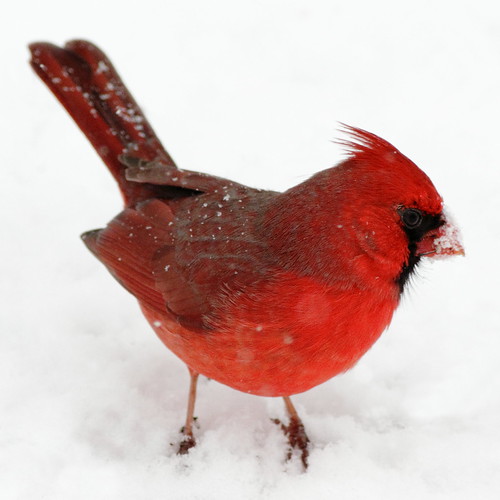 |
| Happy holidays! Male Cardinal in first snow, photo by Jason Matthews |
On a Christmas Bird Count some years ago, we surveyed a wooded area not far from the confluence of the Mississippi and Illinois Rivers. We were joined that New Year’s Day by a Washington University student from Seoul, South Korea. Her favorite bird of the day? A bird many of us take for granted, the Cardinal!
Officially known as the Northern Cardinal, its range covers the Midwest and eastern US, a corner of New Mexico, and an arch-shaped slice of Arizona. It has been introduced in southern California and Oahu, Hawaii.
Besides being a beautiful creature, cardinals are terrific singers—or I should say, whistlers. The function of bird song is to announce, “This is my patch, buddy! Move on!” Or he might sing to his red, red, rose-like
And I will luve thee still, my dear,
Till a’ the seas gang dry…
or the end of nesting season, whichever comes first.
(Apologies to Robbie Burns.) Females of all species vocalize of course, but most do not actually sing songs. Cardinal males and females both sing at all times of the year, though females sing less often, usually from deep cover (The Singing Life of Birds, Donald Kroodsma, 2005).
I’ve been told that cardinals always incorporate a shed snakeskin into the nest. Lots of birds use this as a strategy to discourage predators. Evidently, chipmunks and squirrels find snakeskins very off-putting. An experiment comparing nesting materials found evidence that the tactic works, as reported in the journal the Cooper Ornithological Society, The Condor, 2006, by Medlin and Risch. I had cardinals nesting in the Pipevine in my yard, but their nest was skinless. They did however weave a long sleeve of cellophane from a rope of bubble gum or Laffy Taffy.
As with many bird species, occasionally an individual is found with leucism, a condition in which the animal produces less pigment than the rest of its species. I’ve seen red-tailed hawks with a few all white feathers in the wing and a grackle with several white tail feathers, but it seems paradoxical to call a bird a white cardinal. It’s not surprising then that when a white, cardinal-shaped bird, with pink wings, dark eyes, and a tuft of pink crest landed at a feeder in Tulsa, Oklahoma, it made the channel 6 nightly news. Another beautiful one showed up in Port Isabel, Texas, as did this female in Pedernales Falls State Park, Texas.
Leucism is seen in the presence of white feathers, but what about the absence of black feathers? Well, that amelanism, a condition shown in this male cardinal, that is missing the black mask and instead is all red. I’d love to show you each of these birds, but I’m waiting to receive permission to display the photos in my blog. Until I do, just click on the link to see the bird—very cool!
Such a conspicuous, awesome bird deserves some political attention. The cardinal is the state bird of Illinois, Indiana, Kentucky, North Carolina, Ohio, Virginia, and West Virginia (that’s just in case there isn’t enough identity confusion between the 2 Virginias), and of course, Saint Louis. I refer to the St. Louis baseball Cardinals. The Arizona football Cardinals, having deserted our fair city, now play in Phoenix. They must be named after the slightly paler southwestern subspecies.
Nice post. Also, I really like the new blog template - clean and simple.
ReplyDeleteIsn't it something how we can take some of our coolest birds for granted just because we see them all the time? When I was working in the Australian Outback I think the locals were a bit amused by my parrot fixation, and one of my coworkers who was from England started looking over my life list one day and was amazed and jealous when she saw how many species of wren there are in North America (not to mention hummingbirds, something she'd never seen).
ReplyDelete...The fact that a Phoenix sports team is called the Cardinals perplexes me as well. By paler southwestern subspecies, do you mean the Pyrrhuloxia?
The owner of the "Cardiac Cards" football team moved them out of St. Louis in 1987, but they kept the name they'd had since 1901 (when they were a Chicago team).
ReplyDeleteGetting back to birds, Pyrrhuloxia and the southwestern race of Northern Cardinal occur together in only in southeastern Arizona, but N. Cardinal ranges up to the Nevada/California border. According to the map in The Sibley Guide to Birds, they might just make it to University of Phoenix Stadium. Thanks Rebecca!
Thanks, Beetles! I've been experimenting with templates; glad you like it!
ReplyDeleteA very informative post. Thank you for leaving the link.
ReplyDeleteUp close and personal, I can appreciate a female cardinals more subtle colors, but at a distance, there's just nothing like the way male cardinals "pop" against a drab, brown, winter background.
Someplace or other, I'd read about the snake skin woven into nests, but without attribution I was suspicious this bit of knowledge was folklore. Interesting to know it is both true and effective.
Earlier this year, I came across photos of a yellow cardinal. Assuming this isn't a hoax, it's supposed to be the result of a rare genetic mutation.
Thanks for the link Marvin--what an amazing sight that yellow Cardinal is! Evidently it's not a hoax. There was an article in the Condor about yellow Cardinals in 2003.
ReplyDelete